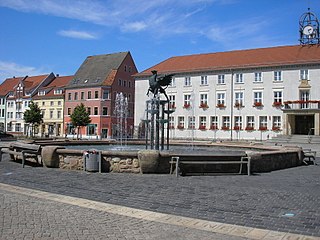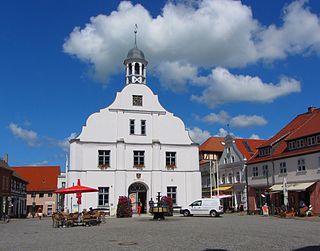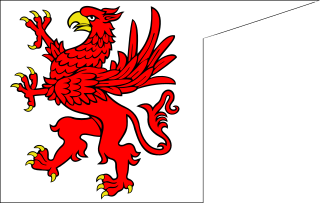
Anklam [German pronunciation: [ˈaŋklam](listen)], formerly known as Tanglim and Wendenburg, is a town in the Western Pomerania region of Mecklenburg-Vorpommern, Germany. It is situated on the banks of the Peene river, just 8 km from its mouth in the Kleines Haff, the western part of the Stettin Lagoon. Anklam has a population of 12,177 (2021) and was the capital of the former Ostvorpommern district. Since September 2011, it has been part of the district of Vorpommern-Greifswald.

Wolgast is a town in the district of Vorpommern-Greifswald, in Mecklenburg-Vorpommern, Germany. It is situated on the bank of the river Peenestrom, vis-a-vis the island of Usedom on the Baltic coast that can be accessed by road and railway via a movable bascule bridge. In December 2004, the town had a population of 12,725.

Friedrich David Gilly was a German architect and the son of the architect David Gilly. His works are influenced by revolutionary architecture (Revolutionsarchitektur). Born in Altdamm, Pomerania,, Gilly was known as a prodigy and the teacher of the young Karl Friedrich Schinkel.

The Treaty of Templin was concluded on 24/25 November 1317, ending a war between the Margraviate of Brandenburg and Denmark, the latter leading a North German alliance. During this war, Brandenburgian margrave Waldemar and his troops were decisively defeated in the 1316 Battle of Gransee, fought at Schulzendorf between Rheinsberg and Gransee. After the battle, Brandenburg was forced to negotiate a truce. The treaty of Templin was signed a year later by Danish king Erich VI Menved, his ally duke Henry II of Mecklenburg, and Waldemar.

Pomerania during the Early Middle Ages covers the History of Pomerania from the 7th to the 11th centuries.
Medieval Pomerania was converted from Slavic paganism to Christianity by Otto von Bamberg in 1124 and 1128, and in 1168 by Absalon.

The Duchy of Pomerania-Stolp, also known as the Duchy of Stolp, and the Duchy of Słupsk, was a feudal duchy in Farther Pomerania. Its capital was Słupsk. It was ruled by the Griffin dynasty. It existed in the High Middle Ages era from 1368 to 1478.

Usedom Abbey was a medieval Premonstratensian monastery on the isle of Usedom near the town of Usedom. It was founded in Grobe and later moved to nearby Pudagla, and is thus also known as Grobe Abbey or Pudagla Abbey respectively.

Ernst Ludwig was duke of Pomerania from 1560 to 1592. From 1569 to 1592, he was duke in the Teilherzogtum Pomerania-Wolgast, sharing the rule over the Duchy of Pomerania with his older brother Johann Friedrich, duke in the other Teilherzogtum Pomerania-Stettin and bishop of Cammin.

Philipp Julius was duke of Pomerania in the Teilherzogtum Pomerania-Wolgast from 1592 to 1625.
The Treaty of Pyzdry was signed on 2 November 1390 between Władysław II Jagiełło, king of Poland and Wartislaw VII of Pomerania-Stolp. The treaty, signed in Pyzdry, contained an oath of vassalage of Wartislaw to Jagiełło, the obligation to support the latter in the Polish-Teutonic War, and mutual trade alleviations for Pomeranian and Polish merchants. Wartislaw VII, who with his brothers was allied with the Teutonic Order before, received the Polish castellany of Nakło and probably some adjacent areas as a fief.
Elizabeth of Doberschütz, née von Strantz was beheaded as a witch on the Hay Market in Stettin and burned on the outskirts of the city
The War of the Succession of Stettin was a conflict between the Dukes of Pomerania and the Elector of Brandenburg. It started in 1464, after the death of Duke Otto III, the last Duke of Pomerania-Stettin. The Dukes of Pomerania-Wolgast, Eric II and Wartislaw X, held that they were Otto's rightful heirs. Elector Frederick II of Brandenburg held that Pomerania-Stettin was a fief of Brandenburg. Since its duke, Otto III, had died without a male heir, it should fall back to Brandenburg.
Bogislaw VII was a Duke of Pomerania-Stettin from the House of Griffins.

Hedwig of Brunswick-Wolfenbüttel, was a princess of Brunswick-Wolfenbüttel by birth and the Duchess of Pomerania by marriage.
New Western Pomerania was that part of Western Pomerania that went to Prussia under the terms of the Congress of Vienna in 1815.

Old Western Pomerania or Old Hither Pomerania was that part of Western Pomerania that went to Prussia under the terms of the Treaty of Stockholm in 1720.
Erich Gülzow was a German local historian, philologist and publisher. He wrote books on the history of Vorpommern and Rügen island. Through his publications on Ernst Moritz Arndt he became known beyond the borders of Pomerania.
Dirk Alvermann is a German historian and archivist.











